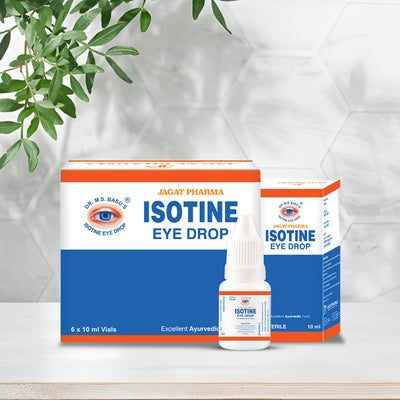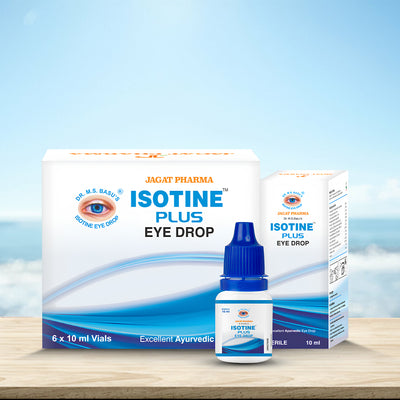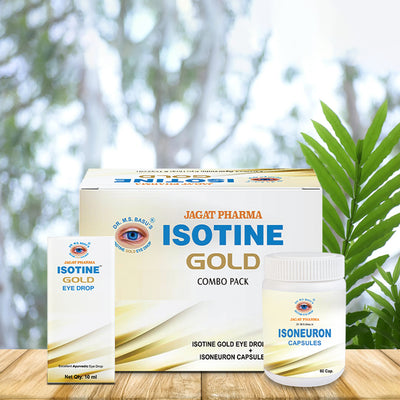
HOW TO PREPARE YOUR EYES FOR THE ALLERGY SEASON
Eye health and allergies are closely intertwined, with allergens like pollen, dust, and pet dander triggering uncomfortable symptoms. Allergic reactions can lead to itchy, red, watery eyes, swelling, and even vision disturbances. Important is how to get your eyes ready for the allergic season? Managing allergies involves minimizing exposure to triggers, such as using air purifiers and keeping windows closed during high pollen seasons. Additionally, over-the-counter or prescription eye drops for allergies can provide relief from symptoms.
ISOTINE Eye Drops for Allergies
Isotine Eye Drops, infused with potent botanical herbs like Palash, Apamarg, Punarnava, and Tuth Bhasma, offer a natural and holistic approach to addressing eye allergies. These powerful herbs are carefully selected for their ability to soothe irritation, reduce inflammation, and promote overall eye health.
For those experiencing allergies these are the best eye drops for allergies that provide a gentle yet effective solution to alleviate symptoms such as redness, itching, and discomfort. By supporting improved blood circulation and reducing oxidative stress, these drops help calm allergic reactions and nourish the eyes' delicate tissues.
Recommended by experts like Dr. Basu, Isotine Eye Drops offer a safe and natural alternative for managing allergies, without the potential side effects associated with traditional medications. Whether you're dealing with seasonal allergies or sensitivities to environmental triggers, regular use of Isotine Eye Drops can provide much-needed relief for individuals of all ages.
Different Types of Allergies
Understanding allergies, especially those that affect the eyes, is crucial for effectively managing and preparing for allergy season. Here's an elaboration on common allergens and how they trigger allergic reactions:
1. Pollen: During spring and summer, pollen emerges as a prevalent allergen that significantly impacts the eyes, constituting one of the most common triggers for allergic reactions. Pollen from trees, grasses, and weeds can be carried by the wind and deposited in the eyes, triggering allergic reactions. When pollen comes into contact with the eyes, the immune system may overreact, releasing histamines that cause symptoms such as itching, redness, and watering of the eyes.
2. Dust: Dust mites are microscopic creatures that thrive indoors, particularly in bedding, upholstered furniture, and carpets. Dust mite allergens can become airborne and irritate the eyes when disturbed, leading to itching, swelling, and irritation. In addition to dust mites, other components of household dust, such as pollen, mold spores, and pet dander, can also trigger allergic reactions in sensitive individuals.
3. Pet Dander: Pet dander consists of tiny dots of skin shed by cats, dogs, and other animals with fur or feathers. These allergens become airborne and settle on surfaces throughout the home, including furniture, carpets, and clothing. When individuals with pet allergies come into contact with pet dander, either directly or through airborne particles, they may experience allergic symptoms such as itchy, watery eyes, sneezing, and nasal congestion.
4. Mold Spores: Mold is a fungus that thrives in damp, humid environments, such as bathrooms, kitchens, and basements. Mold spores can become airborne and irritate the eyes when inhaled or come into direct contact with the eyes. Individuals allergic to mold may experience symptoms such as red, itchy eyes, along with other respiratory symptoms like coughing and wheezing.
Understanding these common allergens and how they trigger allergic reactions is essential for individuals with eye allergies. By identifying and minimizing exposure to allergens, practicing good hygiene, and seeking appropriate medical treatment, individuals can better manage their eye allergy symptoms and prepare for allergy season effectively.
What Are Common Eye Allergy Symptoms?
Itching: Eyes may feel itchy, often accompanied by a strong urge to rub them, exacerbating symptoms.
Redness: Allergic reactions can lead to inflammation, resulting in a red or bloodshot appearance of the whites of the eyes.
Watery Eyes: Excessive tearing or watery discharge from the eyes is a common symptom of eye allergies.
Swelling: Eyelids may become swollen, puffy, or feel heavy due to inflammation and fluid retention.
Burning Sensation: Eyes may feel burning or stinging, particularly when exposed to allergens or peak allergy seasons.
Sensitivity to Light: Some individuals with eye allergies may experience increased sensitivity to light (photophobia), which can cause discomfort in bright environments.
Blurry Vision: In severe cases or when rubbing the eyes excessively, vision may become temporarily blurred due to tear film disruption or corneal irritation.
Gritty Feeling: Eyes may feel gritty or as if a foreign object is present, often due to inflammation and irritation of the conjunctiva (the thin membrane covering the inner surface of the eyelids and the white part of the eye).
Recognizing these symptoms and seeking appropriate treatment to alleviate discomfort and prevent complications is essential. If you experience persistent or severe eye allergy symptoms, consult an eye care professional for evaluation and management.
How do eyes react to allergens?
When exposed to allergens, eyes may react with symptoms such as itching, redness, watering, and swelling. Allergens trigger the release of histamine and other chemicals, leading to inflamma tion and irritation of the conjunctiva—the thin, transparent membrane covering the white part of the eye and the inner eyelids. This allergic response causes discomfort and can temporarily affect vision, highlighting the importance of managing allergies for optimal eye health.
How to limit & relieve eye allergies?
1. Identify and Avoid Allergens: Identify the allergens responsible for triggering your symptoms and implement measures to steer clear of them. Typical culprits encompass pollen, dust mites, pet dander, and mold.
2. Wear Sunglasses: Wear wraparound sunglasses when outdoors to protect your eyes from outdoor allergens like pollen.
3. Practice Good Hygiene: Frequently wash your hands, particularly after outdoor activities or handling pets, to minimize the likelihood of allergens coming into contact with your eyes.
4. Limit Eye Rubbing: Avoid rubbing your eyes, which can worsen symptoms and lead to irritation. Instead, use a cool compress to soothe itching and inflammation.
5. Use Allergy Eye Drops: You can find relief from symptoms like itching, redness, and irritation with over-the-counter or prescription allergy eye drops. It's important to adhere to the provided instructions and take advice from a healthcare professional if necessary.
6. Keep Your Home Clean: Vacuum carpets, dust surfaces, and wash bedding regularly to reduce indoor allergens such as dust mites and pet dander.
7. Stay Hydrated: Staying well-hydrated by drinking ample water can effectively reduce dryness and irritation in the eyes.
Conclusion
In conclusion, managing eye allergies requires a proactive approach to minimize exposure to allergens and alleviate symptoms effectively. By identifying triggers, practicing good hygiene, and utilizing appropriate treatments like allergy eye drops, individuals can mitigate discomfort and maintain optimal eye health. With proper care and attention, navigating allergy seasons can become more manageable, allowing for clearer vision and improved overall well-being.


